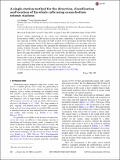Files in this item
A single-station method for the detection, classification and location of fin whale calls using ocean-bottom seismic stations
Item metadata
| dc.contributor.author | Matias, L. | |
| dc.contributor.author | Harris, D. | |
| dc.date.accessioned | 2016-01-24T00:12:16Z | |
| dc.date.available | 2016-01-24T00:12:16Z | |
| dc.date.issued | 2015-07 | |
| dc.identifier | 209216463 | |
| dc.identifier | f4a52fb5-1320-4fd8-aba4-84bd8aa591e9 | |
| dc.identifier | 84938150095 | |
| dc.identifier | 000358929000068 | |
| dc.identifier.citation | Matias , L & Harris , D 2015 , ' A single-station method for the detection, classification and location of fin whale calls using ocean-bottom seismic stations ' , Journal of the Acoustical Society of America , vol. 138 , no. 1 , pp. 504-520 . https://doi.org/10.1121/1.4922706 | en |
| dc.identifier.issn | 0001-4966 | |
| dc.identifier.other | ORCID: /0000-0003-1447-1420/work/61370040 | |
| dc.identifier.uri | https://hdl.handle.net/10023/8064 | |
| dc.description.abstract | Passive seismic monitoring in the oceans uses long-term deployments of Ocean Bottom Seismometers (OBSs). An OBS usually records the three components of ground motion and pressure, typically at 100Hz. This makes the OBS an ideal tool to investigate fin and blue whales that vocalize at frequencies below 45Hz. Previous applications of OBS data to locate whale calls have relied on single channel analyses that disregard the information that is conveyed by the horizontal seismic channels. Recently, Harris, Matias, Thomas, Harwood, and Geissler [J. Acoust. Soc. Am. 134, 3522-3535 (2013)] presented a method that used all four channels recorded by one OBS to derive the range and azimuth of fin whale calls. In this work, the detection, classification, and ranging of calls using this four-channel method were further investigated, focusing on methods to increase the accuracy of range estimates to direct path arrivals. Corrections to account for the influences of the sound speed in the water layer and the velocity structure in the top strata of the seabed were considered. The single station method discussed here is best implemented when OBSs have been deployed in deep water on top of seabed strata with low P-wave velocity. These conditions maximize the ability to detect and estimate ranges to fin whale calls. | |
| dc.format.extent | 17 | |
| dc.format.extent | 1960265 | |
| dc.language.iso | eng | |
| dc.relation.ispartof | Journal of the Acoustical Society of America | en |
| dc.subject | QL Zoology | en |
| dc.subject | HA Statistics | en |
| dc.subject | NDAS | en |
| dc.subject.lcc | QL | en |
| dc.subject.lcc | HA | en |
| dc.title | A single-station method for the detection, classification and location of fin whale calls using ocean-bottom seismic stations | en |
| dc.type | Journal article | en |
| dc.contributor.sponsor | Office of Naval Research | en |
| dc.contributor.institution | University of St Andrews. School of Mathematics and Statistics | en |
| dc.contributor.institution | University of St Andrews. Sea Mammal Research Unit | en |
| dc.contributor.institution | University of St Andrews. Centre for Research into Ecological & Environmental Modelling | en |
| dc.identifier.doi | https://doi.org/10.1121/1.4922706 | |
| dc.description.status | Peer reviewed | en |
| dc.date.embargoedUntil | 2016-01-24 | |
| dc.identifier.grantnumber | N/A | en |
This item appears in the following Collection(s)
Items in the St Andrews Research Repository are protected by copyright, with all rights reserved, unless otherwise indicated.

